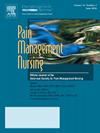A Comparison of the CDC Clinical Practice Guidelines on the Use of Opioids for Pain: Clinical Implications
IF 1.6
4区 医学
Q2 NURSING
引用次数: 0
Abstract
The rate of opioid prescriptions dispensed in the US from 2006 to 2012 increased annually by 1.9%, to an all-time high of 81.3 opioid prescriptions per 100 persons. Prescriber and societal awareness of an opioid epidemic as seen by a rise in opioid use disorder, overdoses and deaths, healthcare providers decreased writing for opioids by 5.2% annually from 2012-2016. By 2020, the rate of prescribing continued to fall to the lowest rate in 15 years, 43.3 opioid prescriptions per 100 persons were filled.
In response to concerns about over prescribing, the CDC endeavored to provide guidance and published CDC Guidelines for Prescribing Opioids for Chronic Pain – United States, 2016. While the effort was well intended there were unintended consequences that negatively impacted patients living with pain such as: an erroneous extension to patient populations not covered in the guideline i.e. (cancer and palliative care patients); rapid opioid tapers; rigid application of opioid dosage thresholds; misapplication of guidance to medications for opioid use disorder; duration limits imposed by insurers and pharmacies; and patient dismissal and abandonment.
These issues and the desire to include patients in shared decision making resulted in new guidance being updated in 2022. The CDC Clinical Practice Guidelines for Prescribing Opioids for Pain – United States, 2022 was released to remediate the adverse effects and include newer research since the earlier 2016 recommendations were made.
A side-by-side comparison of the new recommendations to the old recommendations will allow the nursing audience to know about key differences in each of the 12 domains, the clinical considerations as well as the rationale for the guidance. By better understanding what the government is saying good looks like for opioid prescribing, nurses can help educate patients in their pain care, and improve discussions with pharmacists and insurers, and better communicate with other healthcare providers on the team. The nurse is often the patient educator and advocate; by being informed on the guidelines they can contribute to safer prescribing and improved outcomes.
求助全文
约1分钟内获得全文
求助全文
来源期刊

Pain Management Nursing
医学-护理
CiteScore
3.00
自引率
5.90%
发文量
187
审稿时长
>12 weeks
期刊介绍:
This peer-reviewed journal offers a unique focus on the realm of pain management as it applies to nursing. Original and review articles from experts in the field offer key insights in the areas of clinical practice, advocacy, education, administration, and research. Additional features include practice guidelines and pharmacology updates.
 求助内容:
求助内容: 应助结果提醒方式:
应助结果提醒方式:


